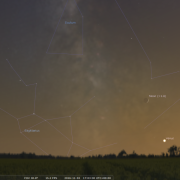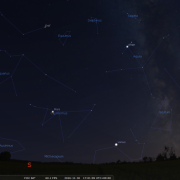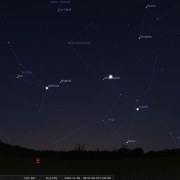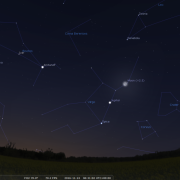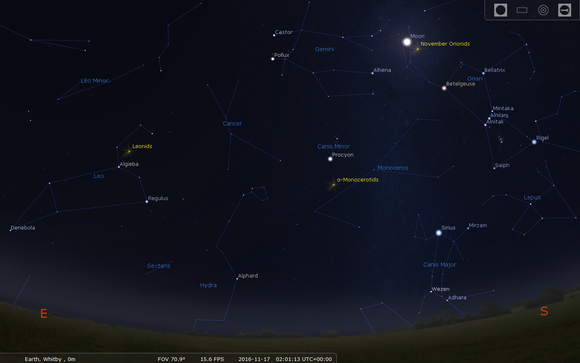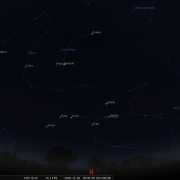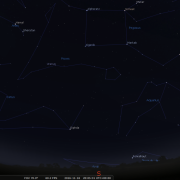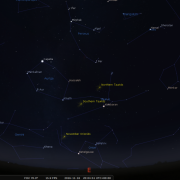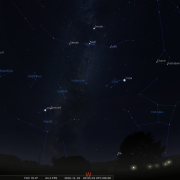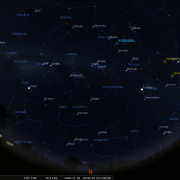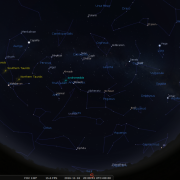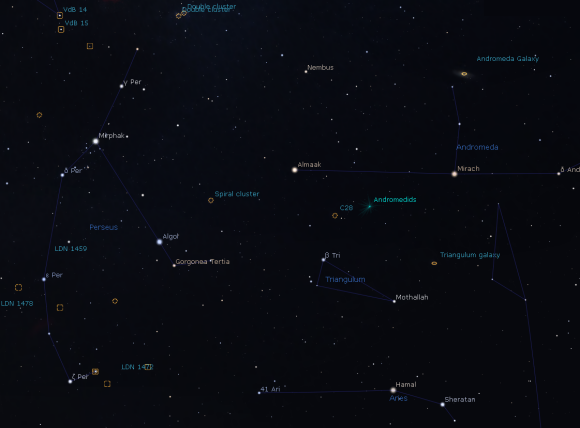Welcome to the WDAS monthly newsletter for November 2016: a digest of the month's latest contributions to our website. Below you'll find Society News, Sky Notes and In-Focus articles printed in full. There's also future events, and trailers for other articles which appear in full on the website - just a click away!
On the website you'll also be able to comment on articles, and if you'd like to play an editorial role in creating new content, just let us know!
Society News
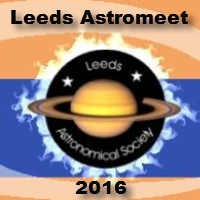 It cannot be a year already, (well, it's not quite) but details of this year’s Leeds Astromeet are out and it looks like an interesting guest speaker line up. The date for your diary is Saturday November 12th, usual venue- Leeds University, Clothworkers Hall – Doors are open from 09:00h with lectures starting at 10:00h. There will be usual trade stalls etc, lectures end at 16:30h. The speakers are:
It cannot be a year already, (well, it's not quite) but details of this year’s Leeds Astromeet are out and it looks like an interesting guest speaker line up. The date for your diary is Saturday November 12th, usual venue- Leeds University, Clothworkers Hall – Doors are open from 09:00h with lectures starting at 10:00h. There will be usual trade stalls etc, lectures end at 16:30h. The speakers are:
- Prof Brad K Gibson: Galaxy Formation.
- Prof David Southwood: Happy Landings – Huygens at Titan; Philae and Rosetta at comet 67P
- Prof Martin A Hendry: Gravity Sand and LIGO was listening.
- Dr A Chapman: lecture TBA
We hope to run at least one car over, possible two. More in Nov Notes.
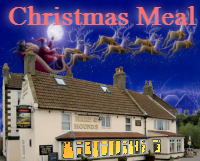 After discussions at last month’s meeting, it looks like we are bound for the Hare and Hounds once again for this year’s Christmas bash.
After discussions at last month’s meeting, it looks like we are bound for the Hare and Hounds once again for this year’s Christmas bash.
It has been provisionally booked for December 9th for 19:30h. 12 places are up for grabs. You'll find the menu below. If you could let Mark know your choices as soon as possible it would be much appreciated.
Here's the Hare & Hounds Christmas Menu, for your perusal:
Christmas Menu for Hare & Hounds at Hawsker, Cost: £24.95 per person
Starters
- Lightly Spiced Carrot Soup
- Game Terrine wrapped in Streaky Bacon with Apple Chutney
- Atlantic Prawn & Smoked Salmon Tian with Marie Rose Sauce
- Portobello Mushrooms in a Garlic & Mature Cheddar Cheese Sauce with a Parsley & Chestnut Topping
(All of the above served with Crusty Bread)
Main Course
- The Hounds Own Turkey Ballantine, stuffed with Sausage Meat, wrapped in Streaky Bacon, served with Creamed Potatoes, Cranberry Jelly & Seasonal Vegetables
- Fillet of Sea Bass on Spring Onion Mashed Potatoes with a Shellfish Sauce
- Beetroot and Goats Cheese Parcel with Buttered New Potatoes and Rocket Salad
- Fillet of Pork stuffed with Black Pudding served with Apple Purée & a Creamy Cider & Whole Grain Mustard Sauce
- The Hounds Festive Pie: Shin of Beef and Stilton Pie with a Rich Shallot Gravy, with Braised Red Cabbage & Creamed Potatoes
- Corn Fed Chicken Breast Filled with Smoked Cheese, wrapped with a Rich Shallot Gravy, with Braised Red Cabbage & Creamed Potatoes.
- Corn Fed Chicken Breast filled with Smoke Cheese, wrapped in Parma Ham, with a White Wine & Tarragon Sauce with Dauphinoise Potatoes
Desserts
- Traditional Christmas Pudding with Brandy Custard
- Cherry and Chocolate Tart with Clotted Cream
- Toffee Apple Cheesecake with Caramel Sauce
- Hounds Mince Pie with Hazelnut Ice Cream
- Cheese Platter; with a Selection of Biscuits & Port Jelly
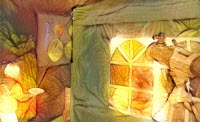 Andy L, Keith and Mark hosted a star party for a charity function organised by Maggie Keating of Ferndene house, Fylingthorpe. The event was to raise funds for the Brighter Futures charity – helping educate children in parts of Africa.
Andy L, Keith and Mark hosted a star party for a charity function organised by Maggie Keating of Ferndene house, Fylingthorpe. The event was to raise funds for the Brighter Futures charity – helping educate children in parts of Africa.
A ‘dancing light’ placard, placed outside the house greeted us as we drew up. With no direct access to the rear garden, all the equipment had to be transported through the house. A gazebo had been erected within the garden itself, which we used to house all the IT and projection equipment, whilst the screen was erected outside.
With skies clouding over only Mark’s 10” scope was used, we did however get a brief glimpse of Mars low down, before it too disappeared behind the clouds. Plan B was always going to be used – so the gathered ensemble, all seated undercover, were treated to one of Mark’s power point presentations. Even the sharp rain showers failed to dampen spirits, although it did dampen Andy and Keith who insisted on staying out of our cosy tent. Homemade soup, bread, and cake sustained us through our journey to the edge of the universe.
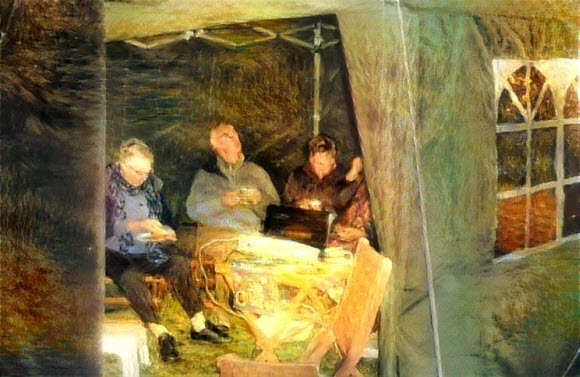
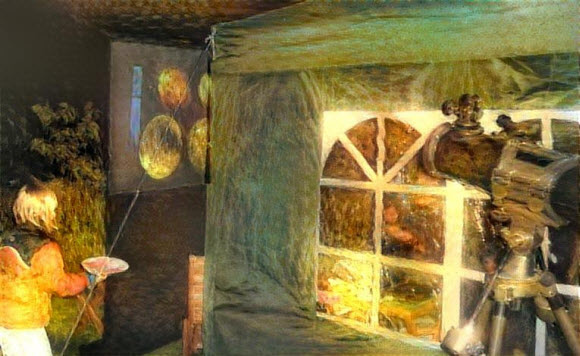
The Great British Space-Off: Inside and Outside the Big Tent.
Guests relax with food while the Universe is projected before them.
Everyone seemed genuinely interested and there were numerous questions. Show over, we packed up and retired indoors to partake in a little more conversation....and a bit more cake, before bidding farewell to our most welcoming host. A most enjoyable evening and £80 raised to boot. Maggie has already suggested another event along similar lines for next year.
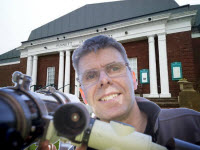 Nice to be back at the museum for a lecture, well at least Mark was; he was giving the lecture to the Whitby Naturalist Society. Mark had been asked some time ago to give a talk about the night sky, and his chosen subject was the diversity of celestial objects astronomers observe. It was slightly odd giving a talk on a Saturday afternoon, however the turnout was far better than Mark was anticipating, 40 plus! Using a power point presentation and the Starry night program, Mark talked for around 50 minutes before fielding a good number of questions, indeed we were in danger of overrunning. Mark hoped everyone had taken something from the presentation, and looked forward to a return some time in the future. Mark thanks Jane Pottas and all at the Naturalist society for their presence and appreciation.
Nice to be back at the museum for a lecture, well at least Mark was; he was giving the lecture to the Whitby Naturalist Society. Mark had been asked some time ago to give a talk about the night sky, and his chosen subject was the diversity of celestial objects astronomers observe. It was slightly odd giving a talk on a Saturday afternoon, however the turnout was far better than Mark was anticipating, 40 plus! Using a power point presentation and the Starry night program, Mark talked for around 50 minutes before fielding a good number of questions, indeed we were in danger of overrunning. Mark hoped everyone had taken something from the presentation, and looked forward to a return some time in the future. Mark thanks Jane Pottas and all at the Naturalist society for their presence and appreciation.
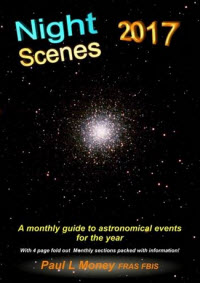 We are now taking orders for Night Scenes 2017. We have actually ordered 22 copies in the end, so if you want to reserve a copy please let Mark know. We don’t have to remind you how excellent, and indispensable the almanac is, so don’t delay. Price will be £4.00 to paid up members (it actually retails in outlets at £7.00) non members £5.50p.
We are now taking orders for Night Scenes 2017. We have actually ordered 22 copies in the end, so if you want to reserve a copy please let Mark know. We don’t have to remind you how excellent, and indispensable the almanac is, so don’t delay. Price will be £4.00 to paid up members (it actually retails in outlets at £7.00) non members £5.50p.
 It’s almost that time of year again – society subscription renewal for the coming year. Rates will be kept at 2016 levels:
It’s almost that time of year again – society subscription renewal for the coming year. Rates will be kept at 2016 levels:
- £12 for Adults
- £6 for Under-16s
You can bring subs along to the W.D.A.S monthly meetings in December, January or February at the very latest. If you cannot make the meetings Cheques are made payable to;- Whitby & District Astronomical Society, Please address to Mark Dawson - 33 laburnum Grove, Whitby. YO21 1HZ.
Sky Notes
In this month's Sky Notes:
Planetary Skylights

 As the November starts, look out for Saturn and Venus on the 2nd and 3rd very low in the SW sky approximately 40 minutes after sunset (around 17:00h) when a very young crescent moon lies above them. You will require an unobstructed horizon, but the view should be great.
As the November starts, look out for Saturn and Venus on the 2nd and 3rd very low in the SW sky approximately 40 minutes after sunset (around 17:00h) when a very young crescent moon lies above them. You will require an unobstructed horizon, but the view should be great.
By the second week in November Saturn is lost to twilight; however Venus remains above the SW horizon, seemingly moving parallel with it, before gradually climbing a little higher into the evening twilight. You cannot mistake Venus – it is exceedingly bright, though apart from noticing it has a phase (currently gibbous) little else will be visible due to the duvet of cloud which permanently shrouds the planet.
 Mars also continues to keep ahead of the evening twilight and is visible above the horizon in the SSW. A waxing moon lies above it on the 6th. Little is now distinguishable on the Martian disk.
Mars also continues to keep ahead of the evening twilight and is visible above the horizon in the SSW. A waxing moon lies above it on the 6th. Little is now distinguishable on the Martian disk.
 Conspicuous Jupiter is now emerging out of the morning twilight, visible by 05:00h low in the east. The moon les close by on the 25th. Speaking of which, the full moon on the 14th will be the closest of the year, a ‘supermoon’. It will appear slightly larger than normal, but certainly not as much as media hype will no doubt make out.
Conspicuous Jupiter is now emerging out of the morning twilight, visible by 05:00h low in the east. The moon les close by on the 25th. Speaking of which, the full moon on the 14th will be the closest of the year, a ‘supermoon’. It will appear slightly larger than normal, but certainly not as much as media hype will no doubt make out.
Meteor Showers

The Leonids are active from Nov 15-20, peaking this year in the early morning hours of Nov 18th. ZHR’s are expected to be normal, ie around 20 per hour, so an observer may expect to view around 7-12. The Leonids are of course famous for their 33-year (or so) periodic outbursts. This coincides with the orbital period of the showers parent comet - Temple Tuttle. The next major outburst is not expected until around 2031 at the earliest.
Keep an eye out for a few meteors on the night of Nov 4/5th when the South Taurid meteor shower reaches a peak, and then again on the night of Nov 11/12 when the North Taurid meteor shower peaks. This is a very long duration shower with a low rate of around 5 meteors per hour. The peak does not increase a great deal from this, however both Taurid showers span over a month so there is a good chance you will spot one or two.
Taurids may well be few, but they tend to produce the odd very bright fireball and therefore well worth keeping an eye out for. The Taurids are an old shower, associated with Comet Enke, which has a period of just 3.3 yrs. Over time dust from this comet has been depleted and spread out over a broad swath of the inner solar system, giving rise to Taurid meteor showers not only on Earth but also on Mars and Venus too!
November 2016 Sky Charts
Click each image to see a full-size Sky Chart:
|
Looking North
Mid-November - 20:00h |
Looking South |
|
Looking East
Mid-November - 20:00h |
Looking West
Mid-November - 20:00h |
|
Overview (Northern Aspect)
Mid-November - 20:00h |
Overview (Southern Aspect)
Mid-November - 20:00h |
Additional Image Credits:
- Planets and Comets where not otherwise mentioned: NASA
- Sky Charts: Stellarium Software
In-Focus
 Look high to the northeast where you will locate one of the northern skies more important constellations, the great hero of Greek mythology, Perseus. Legends associated with Perseus exist in various cultures; some may be traced back as far as the 5th century BC. One tale in particular, his quest to rid the world of the hideous gorgon, Medusa, a creature whose hair was a nest of venomous snakes and glance would literally petrify the unfortunate who looked upon her, is well known, part of which relates to the rescue of the Princess Andromeda. The tale also has a connection with a particular star within the constellation.
Look high to the northeast where you will locate one of the northern skies more important constellations, the great hero of Greek mythology, Perseus. Legends associated with Perseus exist in various cultures; some may be traced back as far as the 5th century BC. One tale in particular, his quest to rid the world of the hideous gorgon, Medusa, a creature whose hair was a nest of venomous snakes and glance would literally petrify the unfortunate who looked upon her, is well known, part of which relates to the rescue of the Princess Andromeda. The tale also has a connection with a particular star within the constellation.
The outline of Perseus itself is comprised of a upward curve of stars; known as the ‘segment’ of Perseus, with two more lines of stars attached to this extending down below. The overall shape reminds me a little of a distorted ‘Pi’ symbol. A Milky Way runs through Perseus, making the whole constellation worthy of close scrutiny with binoculars or a small scope. Alpha Persei, or Mirfak is the brightest star in Perseus, and is located well to the north in the group. Beta Persei or Algol is however the constellations most famous star. The name is derived from the Arabic name for ‘Demon’s Head’; Ras al Ghul and on old star maps Perseus is depicted as holding the severed head of Medusa, which is marked by Algol.
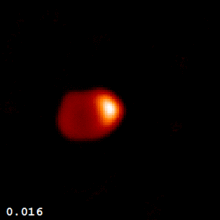
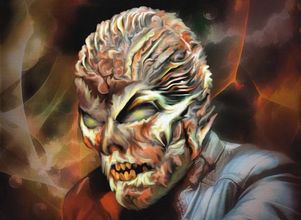
Left: Algol CHARA interferometer animation of the eclipsing binary stars in Algol.
Right: Ghul Illustration
It is rather doubtful if the Arabs knew of the Perseus/Medusa legend, but they had an equally terrible one of their own, a nightmare called a Ghul, that haunted and ultimately destroyed men. The Arabs noted with consternation and suspicion that the star Alghul appeared to wink roughly every third night, fading in brightness before returning to its former glory. The Greeks probably noted the same mysterious phenomena. Indeed most ancient and medieval astrologers considered Algol the most dangerous and unfortunate of stars.
Science has long since uncovered the truth behind Algol and we now know it is an eclipsing binary star; two stars in orbit about each other, one bright and the other fainter. Every 2 days and 21 hours the fainter star passes in front of its more luminous companion, and the overall light output from Algol drops. It remains like this for almost 10 hours before the eclipse ends, thereafter the ‘demon star’ returns to normal.
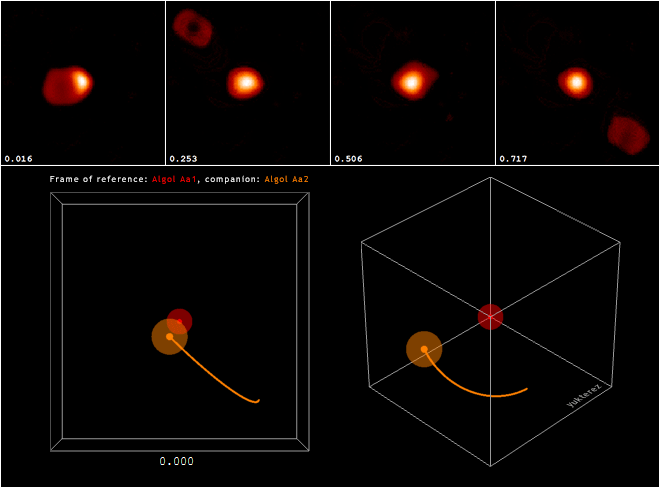
Algol Interpolation: by Simon Tyran, Vienna. (If reading in the newsletter and there's no ani-
mation, trying viewing on the web. Here's one of Simon's websites, with some fascinating images.)
As fascinating as Algol is to follow, it is not a spectacular object – just a star, however Perseus does contain one of the finest sights in the sky.
Far to the northwest of the constellation, roughly midway between it and Cassiopeia- the W constellation, lies a beautiful and amazing double cluster of stars marking the glittering sword of Pereus. On clear, dark nights it is just visible to the naked eye as a hazy smudge of light. Binoculars reveal a bright misty double patch, but through a telescope the Perseus double cluster is a stunning stellar jewel box, which under low magnification fit neatly together in the same field of view. The clusters themselves are located around 7500 light years distant and are separated by just a few hundred light years. Do check them out, you will not be disappointed.
The Ram and the Triangle
Turn your gaze now high to the southeast of the sky, where the stars of Andromeda extend eastwards away from the Square of Pegasus. Located below Andromeda are two small constellations, Triangulum and Aries. Triangulum is a constellation probably few have heard of, but is easy to trace, Aries on the other hand is well known, but I’ll wager few people could indentify its stars. Aries importance is certainly not down to physical characteristics; its stars are not that conspicuous and it contains no showpiece objects, but it once occupied a key position in the heavens.
Thousands of years ago it was noted that the Sun, Moon and bright ‘wandering stars’ or planets, repeatedly stood before certain star patterns. All of these patterns became associated with living creatures and this band became known as the zodiac. By chance back then the Sun stood before the stars of Aries when it crossed the celestial equator on the first day of spring;– the vernal equinox. Throughout antiquity the ram was held in high esteem, often revered, so it seemed fitting that the stars associated with this creature were coincidentally the first sign of the zodiac. Today due to the effects of precession – Earth’s axial wobble, the vernal equinox now lies in Pisces, although it is still referred to as the First point of Aries.
The mythology relating to Aries is actually a prequel to another much loved legend, one that we have all watched at some time, Jason and the Argonauts. The initial legend relates to the king of Thebes, who was tricked by his second wife into sacrificing the children of his first marriage. Zeus, who was much, troubled by this asked swift Hermes to rescue the children- Phrixus and Hellas. Hermes sent a flying ram to their aid, on the back of which they escaped from Thebes without undue hindrance.
Tragically, en-route home the girl; Hellas, fell from the ram and drowned in the place known today as the Hellespont in Greece. On reaching safety within the borders of Colchis, Phrixus sacrificed the ram, whereupon the fleece turned to gold, possessing the power to heal anyone who was covered by it. The Golden Fleece was hung in a sacred grove guarded by a terrible serpent. It was this fleece that was the ultimate goal of Jason and his Argonauts; the familiar segment to this legend, for after many adventures they found and forcibly removed the fleece.
The constellation itself is rather small – a crooked line of 4 stars. Alpha or Hamal is fairly conspicuous – about as bright as Polaris the pole star. Two other stars of the group have proper names, Sheratan and Mesarthim. If you have telescope turn it towards Mesarthim, which is a fine double star, each component so evenly matched in brightness they resemble a distant set of car headlights.
No prizes for guessing the shape of Triangulum, a ‘modern’ group you may think, but actually it is one of the original 48 constellations. Within its borders resides the spiral galaxy M33- otherwise known as the Pinwheel galaxy. It is located just a little further away than the Andromeda galaxy- M31, being the third spiral galaxy of our local neighbourhood, but is much more difficult to spot due to it being orientated face on. Using higher magnifications the observer tends to look straight through this object, so my advice is to use binoculars to spot this faint misty smudge. A good way of locating M33 is to drop straight down from the Andromeda galaxy, but only try on the darkest of nights. Good hunting
Image Credits
- Perseus and Medusa: Superb image seems to have originated from a no-longer-active DeviantArt page.
Events
 Observe the night sky with us at the Bruce Observatory, Whitby School
Observe the night sky with us at the Bruce Observatory, Whitby School
Observing Nights are held weather permitting: check for a relatively clear sky before leaving home. If in doubt, Mark can be reached on 07886069339
Please note the college drive gate is now operated via a electronic key code - so anyone wishing to attend must be at the car park at the top of the drive by 19:00hrs - unless an arrival time has been arranged with Mark/Keith.
 Whitby School - Room H1.
Whitby School - Room H1.
In Members' monthly meetings we usually take a tour of the night sky for the coming month using the Planetarium program. Have talks and presentations on various topics of astronomy/space etc, and discuss future events etc. New members welcome.

